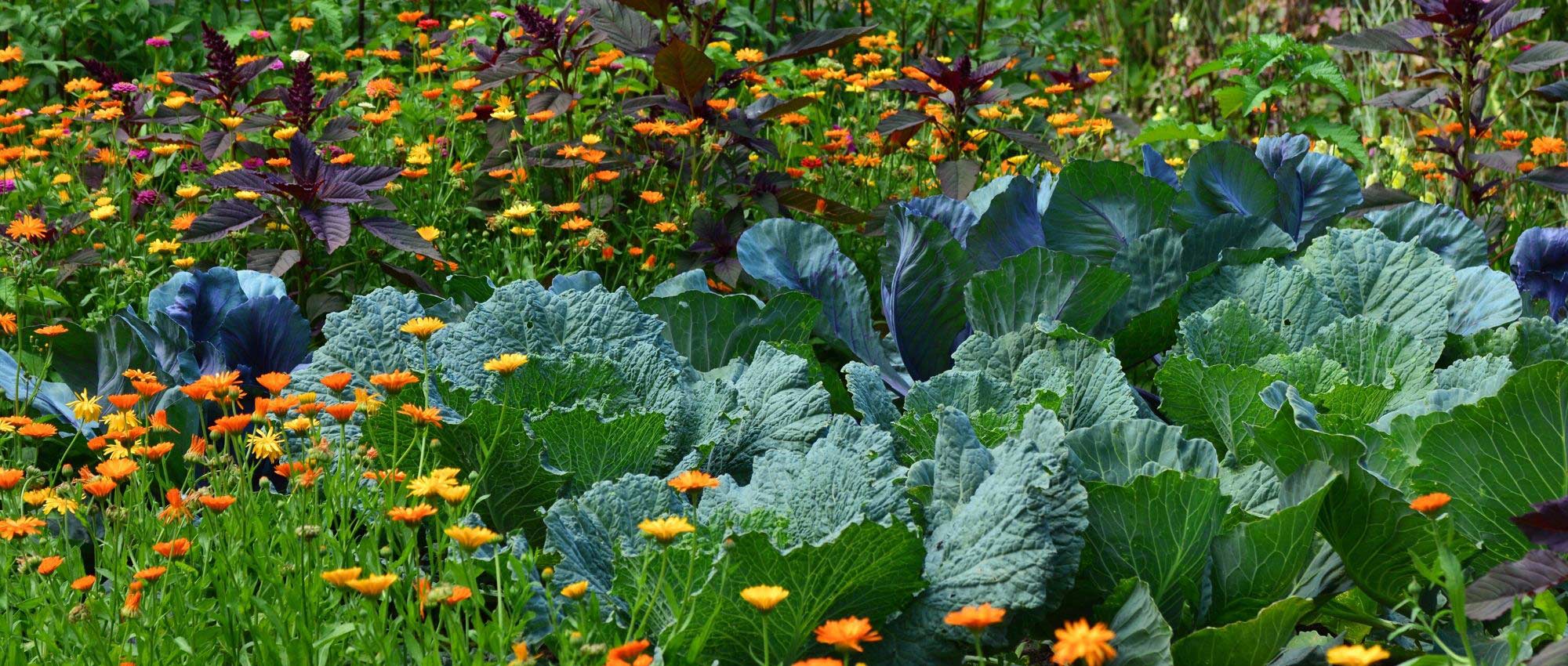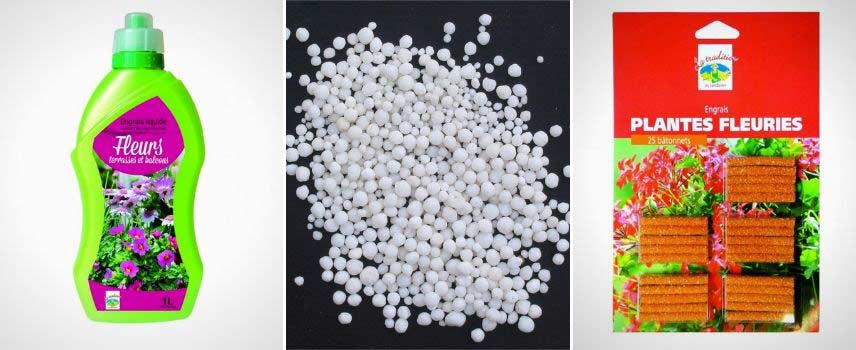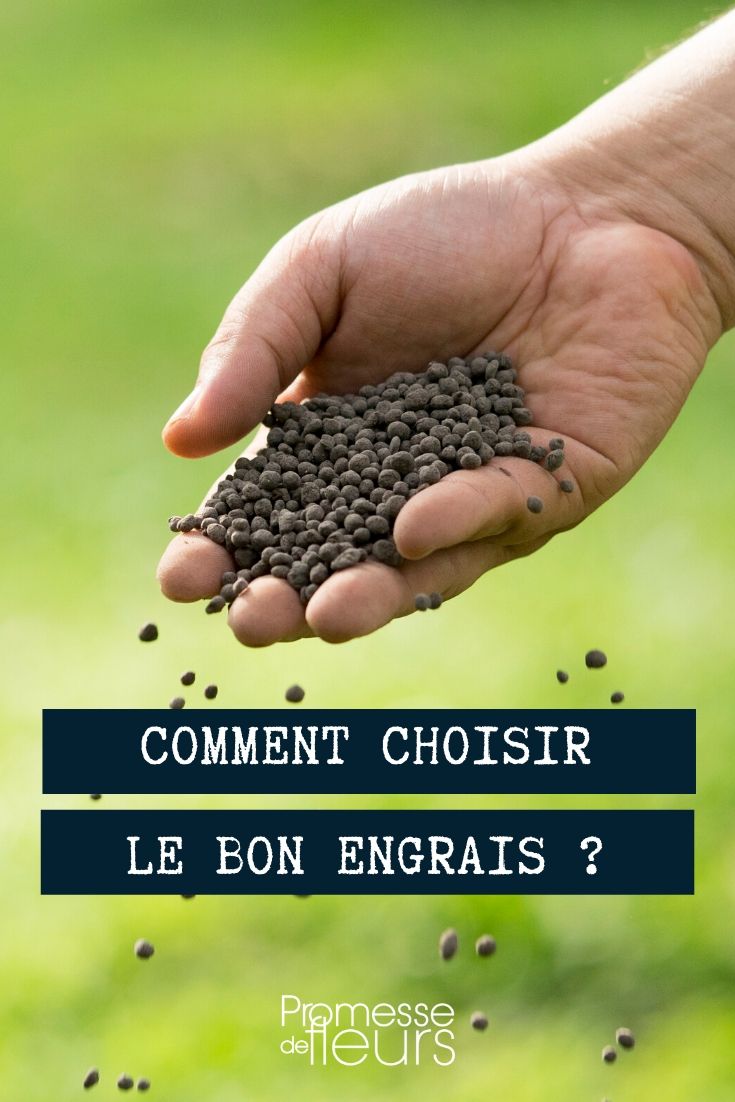
Garden fertiliser: how to choose it?
To fertilise flower beds, vegetable patch, trees and bushes...
Contents
Whether organic or mineral, fertilisers are essential for nourishing plants and fertilising the garden. They improve growth, flowering and fruiting, as well as resistance to diseases and parasitic organisms. They make plants more attractive and vigorous, while nutrient‑deficient plants are scrawny, with foliage that yellows… If organic matter or fertilisers are not added, soil tends to become depleted over time. It is important to maintain its fertility and supply nutrients. It can be hard to find your way among the different types of fertiliser: organic or mineral, for a quick “boost” effect or a long‑term action… We help you see more clearly and find the fertiliser suited to the plants you grow. Also discover the role of nitrogen, phosphorus and potassium in plant metabolism!
Plant needs
To grow, plants draw water and mineral elements from the soil. Among these, they need three main elements:
- Nitrogen (N) promotes growth of above-ground parts of the plant, development of stems and leaves. It takes part in photosynthesis, speeds growth and encourages healthy, well-developed, coloured foliage. Among organic fertilisers, blood meal, horn meal and nettle manure are rich in nitrogen.
- Phosphorus (P) affects development of the root system. It is also important for formation of flowers and fertilization, and therefore for fruiting.
- Potassium (K) improves resistance to diseases and parasitic organisms, as well as to cold. It also promotes flowering and fruiting. Generally, it promotes healthy, balanced growth.
Nitrogen, Phosphorus and Potassium are macronutrients. Plants have significant needs for them, and fertiliser applications are primarily intended to supply these three elements.
Fertilisers indicate their content with three numbers representing the percentage of the three macronutrients… for example: 16-8-12 means the fertiliser contains 16% nitrogen, 8% phosphorus and 12% potassium. Naturally, the higher these numbers, the more concentrated the fertiliser.
A fertiliser is described as balanced when these three values are equal (for example 8-8-8).
Plants also need, in smaller amounts, secondary elements: calcium, sulphur and magnesium. And, in very small amounts, trace elements: iron, boron, manganese, zinc, copper and molybdenum. In general, soil contains enough for plants, but they can also be supplied. They make plants stronger and more resistant. Sometimes secondary elements or trace elements are added to fertilisers: for example, a fertiliser labelled 5-4-12 +3MgO is enriched in magnesia.
It is important to observe recommended doses and avoid overuse of fertilisers. Overdosing with nitrogen fertiliser can make plants more fragile and attract aphids. Plants grow quickly but become more susceptible to diseases and parasitic organisms. Likewise, too high a dose of mineral fertiliser can burn roots. Excess fertiliser also harms mycorrhizal fungi, which play an important role in absorption of water and mineral elements by plants. Nitrogen-rich fertilisers can lead to nitrate pollution, releasing nitrogen into the environment…
Also check the needs of the plants you grow: although most prefer rich soils, some grow better in soils poor in mineral elements.
Fertilisers permitted in organic farming
These are the most natural and environmentally friendly fertilisers.
Choosing an organic or mineral fertiliser?
- Organic fertilisers:
Generally, when talking about organic and natural fertilisers, composts and manures come to mind first. But they can also include crushed horn, blood meal (rich in nitrogen), guano, bone meal, fish-bone meal, nettle manure, seaweed meal… Organic fertilisers have a plant or animal origin.
Composts and manures take time to break down and release their minerals. They enrich soil over the long term while adding humus. They improve soil structure and increase soil water retention. They act as a soil amendment. Composts and manures lighten heavy, compacted soils. They are very useful for improving soil fertility. Organic fertilisers are more often base fertilisers, as they gradually release their minerals as they decompose.
They are mainly applied in autumn, when preparing ground before planting, or later at planting.
Organic fertilisers have the advantage of stimulating soil life. They feed soil micro-organisms. They help maintain a living, fertile soil.
Blood meal and guano are organic fertilisers that release nutrients very quickly. They provide a “boost” effect. They can be applied during the growing season.

Compost, crushed horn and blood meal are organic, natural fertilisers
- Mineral fertiliser:
There are also mineral fertilisers suitable for organic agriculture. The elements they contain are not synthetic chemistry products but have been extracted from the ground. They can be liquid, granulated or in stick form. They are convenient because of their formulation and ease of use. The advantage is that, more precisely than with organic fertilisers, you know the proportion of nitrogen, phosphorus and potassium being applied. This makes it easier to correct a deficiency and to favour, for example, flowering or leaf growth. Unlike composts, crushed horn, blood meal, etc., these fertilisers have a specific formulation for a type of plant, to provide the nutrients that plant needs in priority.
There are also organo-mineral fertilisers.
Choose according to desired effect: long term or boost
- For long-term action: For a long-lasting effect, we recommend applying compost or manure, which take a long time to fully decompose and release their nutrients. You can apply them in autumn or before planting. They improve soil in a durable way. You can also choose a fertiliser such as “La Belle Bouse”, which gradually releases mineral elements over about three months. Crushed horn is also a natural fertiliser that decomposes slowly. To learn more, see our advice sheet on pelleted manure and how to use it well in the garden.
- For a “quick boost” effect: For a rapid action, for example to correct a deficiency, favour liquid mineral fertilisers, to dilute in watering water. You can also apply blood meal or guano, which break down quickly and are particularly rich in nitrogen.
Choose fertiliser according to the plant
Some fertilisers are universal, meaning they are standard and suitable for all plants, while others are specific, intended for a particular type of plant (roses, citrus trees, hydrangeas…), to cover more tailored needs.
If a plant is deficient in a particular element, it is possible to find it: phosphate, potash, anti-deficiency iron, anti-deficiency magnesium… If needed, you can also apply a set of trace elements.
- For roses and flowering bushes
For roses and flowering bushes (lilac, ceanothus, weigela, wisteria…), favour fertilisers rich in potassium, which will encourage abundant flowering. Choose a long-lasting fertiliser, presented as granules to incorporate into soil. For hydrangeas and bushes for heather soil, there are specific fertilisers.
- For plants in pots or window boxes:
Plants grown in window boxes or pots, for example to create floral arrangements, have high needs because substrate becomes exhausted over time. For flowering plants such as pelargoniums, pansies, begonias or petunias, choose fertilisers especially rich in potassium and phosphorus, while for ornamental foliage plants (Ipomoea, Coleus, Muehlenbeckia, Dichondra…), it is better to favour fertilisers rich in nitrogen.
We particularly recommend the natural fertiliser “La Belle Bouse”, which will gradually release mineral elements for about three months. If necessary, you can supplement with some liquid fertiliser applications during the season.
- For the vegetable garden:
For the vegetable garden, the aim is to promote vegetable production and disease resistance. Choose fertilisers mainly rich in potassium. We recommend a slow-release granular fertiliser to spread at the start of spring, before planting and sowing vegetables. You can also make some additional applications during the growing season. We particularly recommend Solabiol vegetable garden fertiliser, which includes a root growth stimulant, or Promesse de Fleurs fertiliser for tomatoes and fruiting vegetables, suitable for organic farming, more aimed at fruiting vegetables (tomatoes, aubergines, peppers, etc.).
It is possible to tailor your choice according to the vegetables you grow: leafy vegetables (cabbages, lettuces, leeks…) need more nitrogen, root vegetables (potatoes, carrots, radishes…) require more phosphorus. Fruiting vegetables, such as tomatoes, aubergines and peppers, mainly need potassium.
- For fruit trees:
For fruit trees (apple, plum, cherry trees, but also citrus trees), the important thing is to supply potassium. It is also useful to choose a fertiliser enriched with magnesium. Choose, for example, the Promesse de Fleurs UAB fertiliser for fruit trees, which also includes a root growth stimulant and comes as granules to incorporate into soil.
- For houseplants:
For houseplants (palms, ficus, philodendrons…), favour leaf growth so foliage is green and luxuriant by supplying nitrogen. If you have flowering houseplants (Anthurium, Vriesea, Kalanchoe…), potassium will also be important. A practical solution: sticks to plant in pots that gradually release mineral elements. There are also specific fertilisers for orchids and cacti.
- For the lawn:
Here the aim is a green, dense lawn, so choose a fertiliser rich in nitrogen, as this element promotes leaf growth. For ease of use, choose a granular fertiliser to spread.
Finally, discover Tonnerre d’engrais, a natural fertiliser, practical, versatile and economical… Olivier presents it in a video!
Chemical fertilisers
Although derived from chemistry and therefore less natural, these fertilisers cause no problem when correctly dosed. Compared with organic and natural fertilisers, they are generally more concentrated in mineral elements and are effective at correcting deficiencies or boosting plant growth.
Choose according to fertiliser type: solid or liquid
- Solid form : fertilisers can take the form of granules or sticks. These are slow-release fertilisers that release their nutrients gradually… Granules are mixed into substrate at planting or repotting. They can also be placed on top of substrate during cultivation, or lightly incorporated into soil. Sticks are a good solution for potted plants. Simply insert them into potting compost and they will progressively release their mineral elements.
- Liquid fertilisers. They act as a quick boost. These are concentrated solutions that are diluted in watering water. Regular applications are needed during cultivation, as they do not remain long in the substrate. They are widely used for houseplants.

Chemical fertilisers are available in different forms: liquid, granules or sticks
Choose according to desired effect: long-term or a boost?
- Base or slow-release fertilisers: These fertilisers act over the long term, releasing mineral elements gradually. Slow-release chemical fertilisers come as granules, sticks or small plastic-coated beads. They can be placed in planting hole for plants in open ground, mixed into substrate when repotting a plant, or simply placed on surface of pot.
- Maintenance fertilisers, or “boost” : These fertilisers give a boost because mineral elements are immediately available to plants. They are generally liquid fertilisers, to be diluted in watering water. They are applied mainly during growth, in spring, and then throughout growing season until late summer–autumn. They are also used to correct a deficiency quickly.
- There are also foliar fertilisers, to be sprayed onto foliage. They are mainly intended for deficient plants, to correct deficiency very quickly. Fertiliser will be absorbed through leaf stomata. Mineral elements are immediately assimilated by plant. It is a supplementary treatment to correct a deficiency or support a plant that has undergone stress.
Which fertiliser for which type of plant?
- Roses and flowering bushes:
For roses and flowering bushes, the most important is to provide potassium to ensure generous flowering. You can for example choose this fertiliser. For bushes that prefer heather soil (hydrangeas, azaleas, rhododendrons…), choose a specific fertiliser.
- Potted plants or planters:
Choose a granular fertiliser, to mix into potting compost, or a liquid fertiliser, to dilute in watering water.
- Vegetable garden:
To encourage good harvests in the vegetable garden, you can use this potassium-rich fertiliser, which is available as granules.
- Houseplants:
For houseplants, use a liquid fertiliser, applied regularly by diluting in watering water. For orchids, choose a specific fertiliser.
- Lawn:
For lawn, choose a nitrogen-rich fertiliser, which will promote foliage growth of grasses.
- Subscribe!
- Contents
































Comments